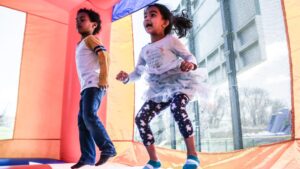Today’s youth are increasingly turned off by reading books.
Ellen Jarrett has always loved books, but she describes her youngest son, Drew, as “a reluctant reader.”
“He never enjoyed sitting and reading by himself,” says Jarrett, who lives in Owings Mills and works for CHAI, or Comprehensive Housing Assistance Inc. “I would take him to the library, encourage him to take out books, and he would just sit there.”
Now 17, Drew, a junior at McDonogh School, gets good grades but avoids honors and AP courses requiring a lot of reading. “He reads what is required for school, but no more,” says Jarrett.
A 2014 study conducted by Common Sense Media found the number of children and teens who read for pleasure has steadily declined for decades. According to the study, “Thirty-three percent of 13-year-olds and 45 percent of 17-year-olds say they read for pleasure no more than one to two times a year.”
The study also found the number of 13-year-olds who “say they never or hardly ever read” increased from 8 percent in 1984 to 22 percent in 2014, and the number of 17-year-olds who reported the same during that time period has increased from 9 percent to 27 percent.
Fran Bowman is founder and director of the Columbia-based Bowman Educational Services and MultiFlex Educational Services. She also is the author of “Bowman’s Orton-Gillingham ‘Plus’ Guidebook” and co-founder of OgStar Reading, a new game-based reading app that teaches reading using the Orton-Gillingham approach.
“I work mostly with kids with dyslexia who hate to read,” says Bowman. She says as many as 20 percent of all students have the language-based learning disorder. In addition, Bowman believes that in today’s world, youngsters without dyslexia are “acting more like dyslexics.”
She believes that’s due to advances in technology. “Tech has usurped the time that was once used for reading,” she says.
Says Stephanie Nislow, an educator and tutor certified in the Orton-Gillingham method and co-founder of OgStar Reading: “There are just so many distractions that make it hard for a kid to sit down with a book. There used to be [only] three shows [at a time] on TV. … Nowadays, even kids who read well aren’t so likely to pick up a book.”
It’s not that Bowman and Nislow are anti-technology. Their new app uses technology to engage children in reading.
“Dyslexic kids do best with audio or immersive [eye and ear reading],” Bowman says. “In immersive reading, they listen to electronic audio books while they read along with the highlighted text on their screens. … In the last 10 years, there’s been a major shift. Now, listening to a book on audio or immersive reading are valid choices. You can get anything in any format, and dyslexic students don’t need to feel different anymore.”
Still, Bowman and Nislow worry that technological developments have made students less likely to read. “People don’t read a lot of words. It’s mostly pictures and logos,” says Bowman. “They don’t read a whole New York Times article; they just read the headlines.”
Jonathan Willis, an English teacher in Baltimore County Public Schools, says while his ninth- and 10th-grade students still read, their reading habits have changed.
“They’re immersed in media, social as well as information they receive in their news feeds,” Willis says. “They’re aware of current events, but don’t necessarily go in depth. It seems students are afraid of literary genres like novels or short stories because schools haven’t trained them to read larger pieces of texts.”
Nislow says many students graduate from high school without the reading proficiency required to complete a job application. She mourns the fact that children are missing out on the joy that books can bring.
“I feel like an old fogey,” says Nislow. “But I think of my own childhood and how much fun it was to be reading the same book and sharing it with my friend.”
Still, the news isn’t all bleak. “Making the app has made me see that people still need and want to read,” says Bowman. “[Teachers] talk about how kids still view being able to read as being smart. Despite all these changes, literacy is still the cornerstone of being educated. It’s still the ticket to having a bright future.”
What can parents do to encourage their children to read? Nislow says they can read themselves. “Parents aren’t modeling reading for their kids,” she says. “If it’s a family activity and everyone is sitting around reading, kids are more likely to join in.”
Nislow recommends “tying literature choices to kids’ other interests. If a kid’s really interested in sports, find sports books. If he only likes reading short passages, perhaps find some humorous poetry. Parents should worry less about the quality of the literature their children read and more about the quantity.”
And don’t be afraid to visit a library, advises Bowman. “Visit a library on a weekly basis, just to roam around and find interesting things to read,” she says. “Our kids are sometimes so busy going from activity to activity that families spend less and less time at the library.”





